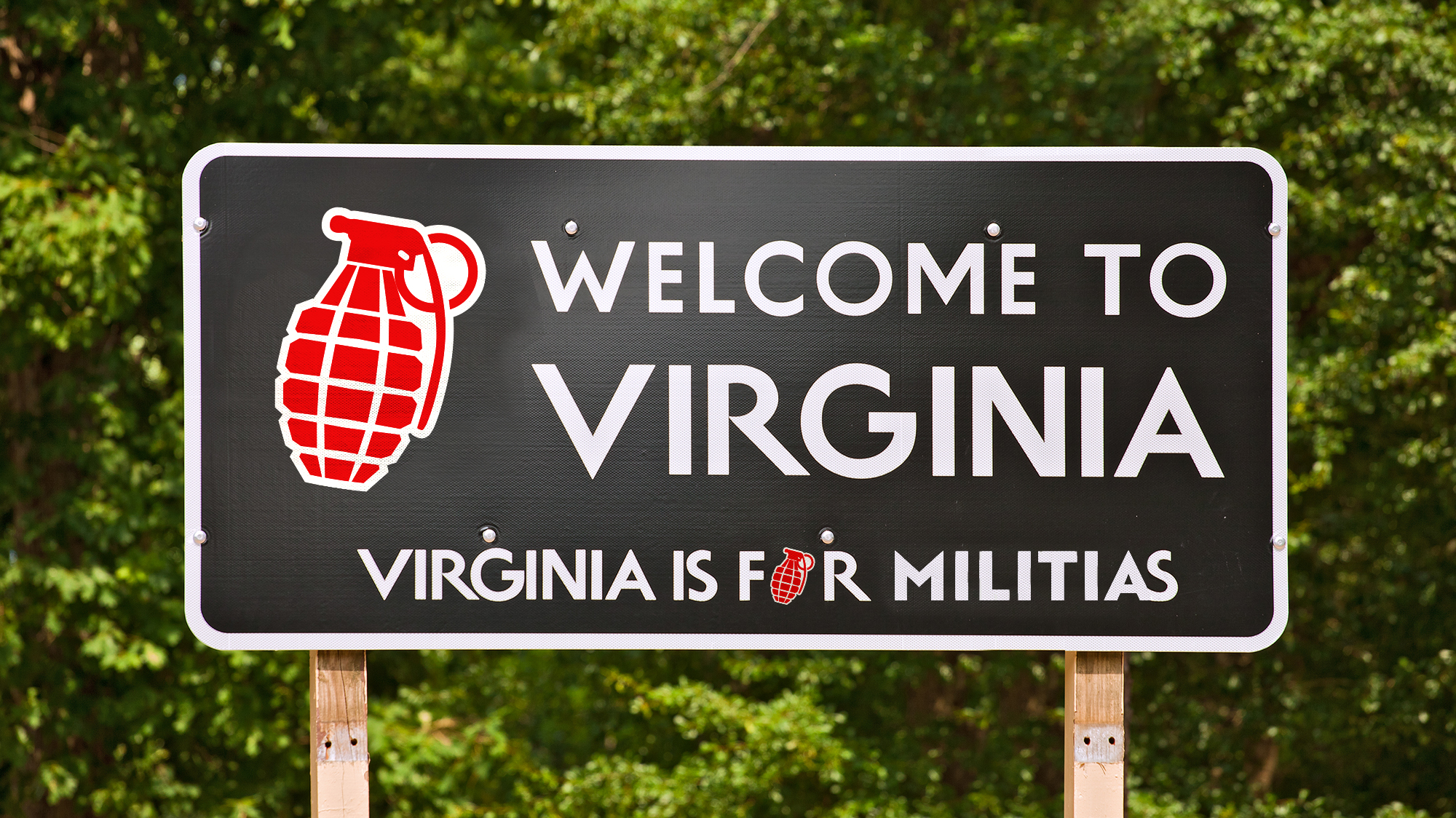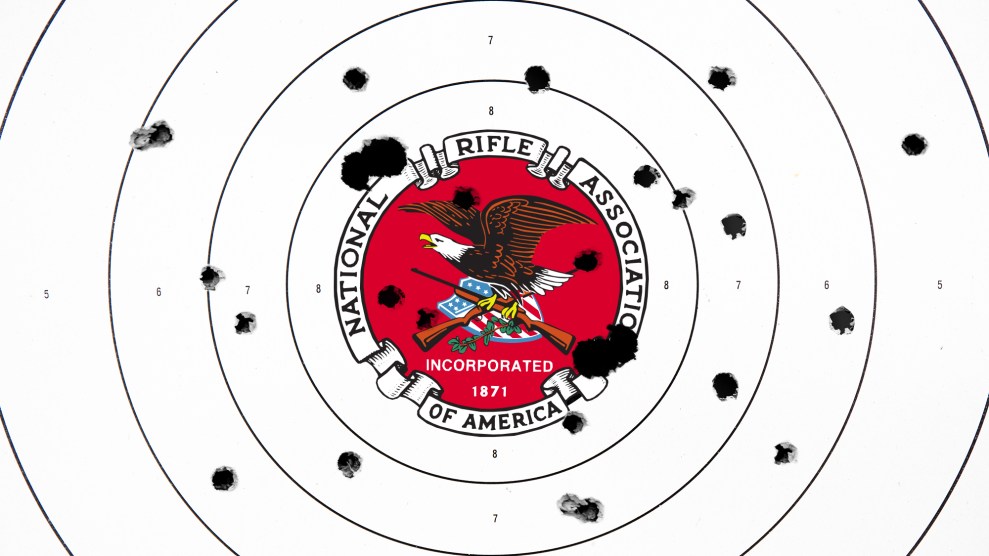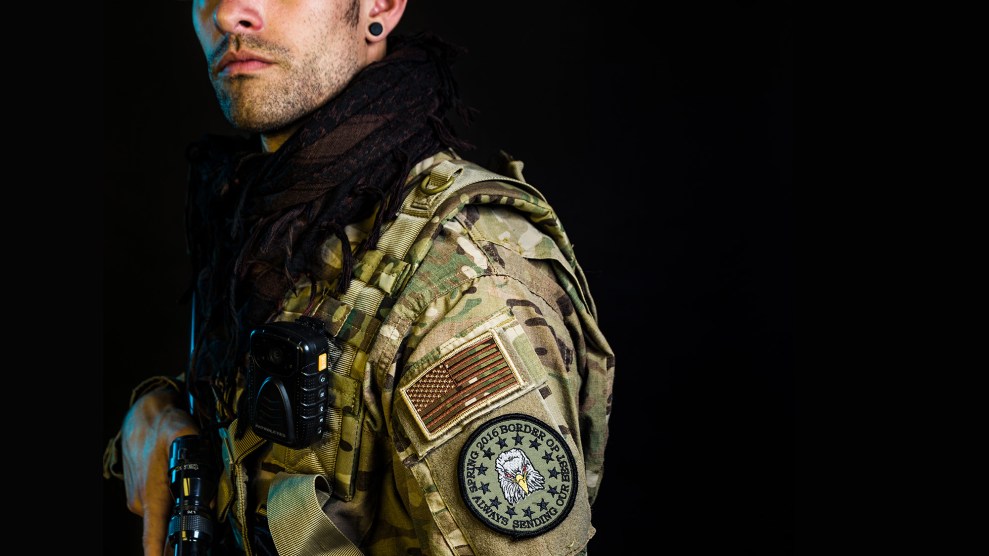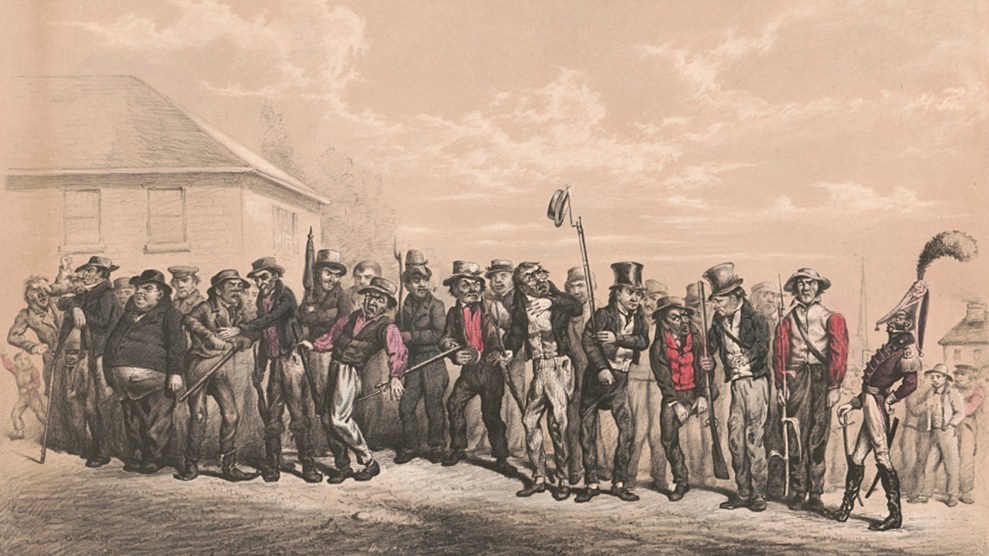On a dry, bright afternoon in late June, members of the Bedford Militia lined up on a grassy lot on the property of Bryan Buchanan Auto Auction, right off the county highway in Montvale, Virginia. The group of about a few dozen stood in formation still as water, a US flag on one side and the squad’s guidon bearer holding up the militia’s flag on the other, the Blue Ridge Mountains in the distance. All were dressed in military fatigues and about half had a sidearm strapped to their hip. Bob Good, a Republican serving his first term in the US House representing the region, was on stage getting fired up, discussing his efforts on Capitol Hill to defend the Constitution, by which he meant the Second Amendment.
Good warned the audience that Joe Biden and the Democratic Party would not rest until they took away every gun in the country and forced critical race theory—the latest Republican boogeyman—into every classroom. The only thing preventing this leftist fever dream from becoming reality was the militia and their supporters, “proud patriots and constitutional conservatives who are doing their part to help strengthen our nation and to fight for the things that we believe in,” he said to rapturous applause.
Good had been invited to speak by the Bedford Militia for its second annual muster—the military term for an assembly of troops for inspection. And perhaps, in a different context, his speech might have sounded like a rallying cry before a big battle. But here in Montvale, there was no sign of a fight. There was a coffee stand and a barbecue truck stationed next to the stage. Local artisans set up tents to sell homemade jewelry and other crafts. Under one tent, militia members and other attendees of the muster could spin a giant wheel for a chance to win prizes donated by local businesses. If it hadn’t been for the abundance of military uniforms and guns, you’d have thought you just walked into a small county fair. Come on down to the paramilitary muster and win free passes for mini golf.
For more articles read aloud: download the Audm iPhone app.
Loosely affiliated groups of armed militias are nothing new to the American landscape, but by the count of the Anti-Defamation League, the number of militias in the US quadrupled between 2007 and late 2009. While their ranks have thinned slightly in the past two years, according to a recent report from the Southern Poverty Law Center, another joint report from the Armed Conflict Location & Event Data Project and MilitiaWatch, a nonprofit that tracks political violence, explains how these groups have ramped up their activity. At first, they came together to protest state mask mandates and shutdowns to stop the spread of COVID-19, then to square off against Black Lives Matter activists during a summer of intense protest, then to rally at ballot-counting centers on behalf of Donald Trump’s Big Lie, and then, finally, to storm the US Capitol on January 6 in an attempt to overturn the results of the election.
Amid the rise of far-right extremist groups nationwide, Virginia is the only state where local governments are legitimizing their regional militias. In Bedford County and its neighboring Campbell County the local governments are trying to rebrand their militias from extremist paramilitary groups operating on the fringe of society into an official arm of the state—one with a more family-friendly image of protecting neighbors rather than bombing government buildings. “It’s sad at this point that the militia is a scary term, because historically it’s not a scary term,” Jonathan Falls, the commander of the Bedford Militia, told his troops at the muster. “Historically it’s a very honorable thing to do in your community, and so part of our mission is to change the definition of the militia back to what its original, historical meaning was.”
In May 2020, the Bedford County Board of Supervisors passed a resolution officially recognizing the militia; Campbell County had passed an identical resolution a couple months prior. “Legally, it means nothing,” Mary McCord, the executive director of Georgetown Law’s Institute for Constitutional Advocacy and Protection, says of the resolution. Under Virginia state law, only the governor has the authority to call forth militias. But, McCord warns, the resolution gives the militia a “veneer of sanctioned credibility,” the consequences of which can be severe.
That’s the vibe I got when I attended the Bedford Militia’s muster in June, at which Good was far from the only local politician to speak and praise the militia. Three members of the Bedford County Board of Supervisors, along with a Virginia state delegate, spoke and lauded the efforts of the militia members, citing some of the work they’ve done in the community, which has included cleaning up debris after storms and leading a search-and-rescue effort for a missing hiker. Even the Bedford County sheriff, Mike Miller, who was originally scheduled to make an appearance, sent a note of appreciation to the militia that was read on stage.
The state of Virginia has a very clear anti-paramilitary law—all paramilitary activity that includes teaching, demonstrating, or assembling one or more people for the purpose of training with firearms is explicitly prohibited—but laws are only as strong as a local law enforcement’s appetite for enforcing them. In a county like Bedford, what incentive does the locally elected sheriff have to enforce such laws when he knows that enough people in his community support the militia? “You just might as well resign now because you’re not going to get reelected,” McCord says.
But when I visited Bedford County, I was less interested in what life was like for members of the militia and their supporters. Not everyone in the area is on board with the paramilitary organization, and people who have publicly opposed the militia’s formation and official recognition say that they’ve been targeted, harassed, and doxxed by militia members and their supporters. And though Bedford and Campbell Counties are overwhelmingly white, the people of color who live in the area, which includes the neighboring city of Lynchburg, have felt targeted by government-sanctioned groups of mostly white people carrying guns in public.
Despite the positive image that the Bedford Militia wants to project, the truth is that they are a group of armed civilians whose mission is “combating community deterioration and juvenile delinquency” along with providing “community security.” Determining what exactly that means and when and where it’s necessary for an armed group of civilians without any kind of public oversight to get involved is, at best, controversial. At worst, it’s what led to much of the violence that took place last summer at protests in the wake of George Floyd’s murder. Just as many other militias took to the streets opposite Black Lives Matter protests, so did the Bedford Militia, in an armed standoff that led to a riot in Lynchburg that the community is still reeling from.

Joshua Carr loves to tell stories. The 21-year-old acting major at the University of Lynchburg is a self-proclaimed history buff, especially when it comes to Black history and his hometown of Lynchburg. “Marcus Garvey, Langston Hughes, W.E.B. Du Bois used to literally come here on weekends,” he tells me excitedly on a sunny spring afternoon in early April. The literati would travel to this city of 80,000 in the southern part of the state to see Anne Spencer, a Harlem Renaissance poet—even though she lived in Lynchburg (where she founded the local chapter of the NAACP in 1918) and only wrote letters to her compatriots in New York. Carr gets animated as he darts across his small but cozy apartment in the city’s downtown, pointing from his window to different parts of town where Spencer and her friends would hang out.
Carr’s love of these figures inspired him to get involved with his local Black Lives Matter chapter in 2019, a role that became even more urgent during the uprising last year following the police murders of George Floyd and Breonna Taylor. It wasn’t long after Carr started organizing with Black Lives Matter Lynchburg that he had a violent confrontation with the nearby militias that still haunts him. When I ask Carr what happened on May 31, 2020, he turns off the theatrics and looks at me solemnly. “I almost died last year because of that shit,” he says, quiet and sober.
It started a couple days after Floyd’s murder, when the Twitter account for Fifth and Federal Station, a whiskey bar and barbecue restaurant in downtown Lynchburg, traded racist jokes with Jerry Falwell Jr., the disgraced former president of Liberty University. Local breweries and distilleries stopped supplying booze to Fifth and Federal, whose owner, Josh Read, initially refused to apologize. “That was a smack in our face,” Carr says about the tweet. Fifth and Federal is situated in a part of town that has a large Black population, not far from the street where Carr grew up. “We give you money. We help you.”
On Sunday, four days later, protesters convened outside of the restaurant, which sits on the northwest corner of a traffic circle in downtown Lynchburg, across the street from a Family Dollar, where Carr works part-time as an assistant store manager. By all accounts the daytime protests were peaceful. Hundreds of people marched through downtown until they reached the restaurant. But as it grew dark, the situation turned tense. Police presence was sparse. Instead, armed members of both the Bedford and the Campbell militias posted up in and around the restaurant. Just days earlier, the Bedford Board of Supervisors had voted 5–2 in favor of their militia resolution. At one point, Read, the restaurant’s owner, came out to address the protesters: “We got guns,” he warned. While the militias may have only been from nearby counties, they viewed it as their mission to defend the restaurant from an unruly mob of Black Lives Matter protesters, under orders from their county government. They even claimed that the local police had called for their help to control the situation, though police told local press that they had not contacted the militia for backup.
By the time Carr got to the protest, shortly after 9 p.m., the militia was already there. He immediately spotted the snipers. One man was on top of the restaurant, with an AR-15–style rifle pointed toward the protesters. Across the street, at the Family Dollar, another sniper was posted on the roof, a rifle aimed toward the crowd. More police began to arrive as tensions grew. After a couple of hours, Carr says, all hell broke loose. “The next thing you know, a shot fires out from the top of the goddamn building of the Family Dollar,” he recalls. That sent the protesters scattering. Some ran away fearing for their life; others fought back, picking up rocks and other objects and throwing them at the restaurant and at the police, who started spraying chemical irritants to disperse the crowd.
One protester was arrested and sentenced to a month in jail after he was found guilty of participating in a riot, a misdemeanor charge. Another went before a city grand jury in April on charges that include throwing a water bottle. In June 2021, 24-year-old Edwin Kyle Demerly pleaded guilty to starting the Fifth and Federal riot by setting off fireworks, launching the peaceful demonstration into a violent frenzy. But in addressing the court during his sentencing, Demerly said the riot was aggravated by the militia members and their aggression against minority groups. No charges were ever brought against any of the armed militia members who attended the protest.
Carr says that, since the Fifth and Federal protest, neither he nor his other BLM Lynchburg organizers have had any further physical confrontations with militia members. But he says both the BLM Lynchburg and his personal social media accounts have since received harassment and racist messages from white locals whom he suspects have militia ties. To Carr, it’s troubling but not surprising; he and his fellow BLM organizers have had to deal with racial oppression their whole lives, and the threat of harassment from white militia members is almost expected. “It’s a ‘We’re white supremacists, we can do that bullshit’ kind of mentality,” he says.

Falling Creek Park is something of a jewel in Bedford’s crown. Situated in the center of the county, it was the first of four planned regional multipurpose parks meant to attract tourists to the rural area when it opened in 2009. Ten miles of serene, wooded hiking trails surround the rolling green hills of the park. There are several picnic areas, a couple playgrounds, a skate park, and even a 36-hole disc golf course. At the edge of the park’s sprawling meadow sits a nursing home that offers residents an idyllic view of the manicured vistas. It’s a park that really takes pains to offer something for everyone. And that includes the local militia.
On February 15, 2020, Wes Gardner and Daniel Abbott, then the self-proclaimed organizers of the Campbell and Bedford Militias, held a muster at Falling Creek Park. It was a sort of coming-out party for the nascent militia, which Gardner and Abbott had formed only a few weeks earlier, after attending a massive gun rights rally in Richmond, Virginia. On January 20, tens of thousands of fellow gun advocates gathered in front of the state Capitol. The protest, which was organized by the extremist gun rights group the Virginia Citizens Defense League, was directly responsible for kickstarting the state’s budding militia revival. Philip Van Cleave, the president of the VCDL, emceed the rally and introduced a slew of speakers who railed against the state’s newly elected Democratic majority. They warned protesters that the Democrats would soon be coming for their guns and that the crowd had better be prepared to defend their civil liberties—by any means necessary.
Gardner, a gunsmith who owns a gun shop in Campbell County, and Abbott, who serves in the Virginia National Guard, took the message to heart. Within weeks they put out word that they wanted to form a militia in both Bedford and Campbell. Their call to arms spread far and wide, with flyers posted at shops and restaurants throughout the county, and on popular Facebook pages that publicize local events and community news.
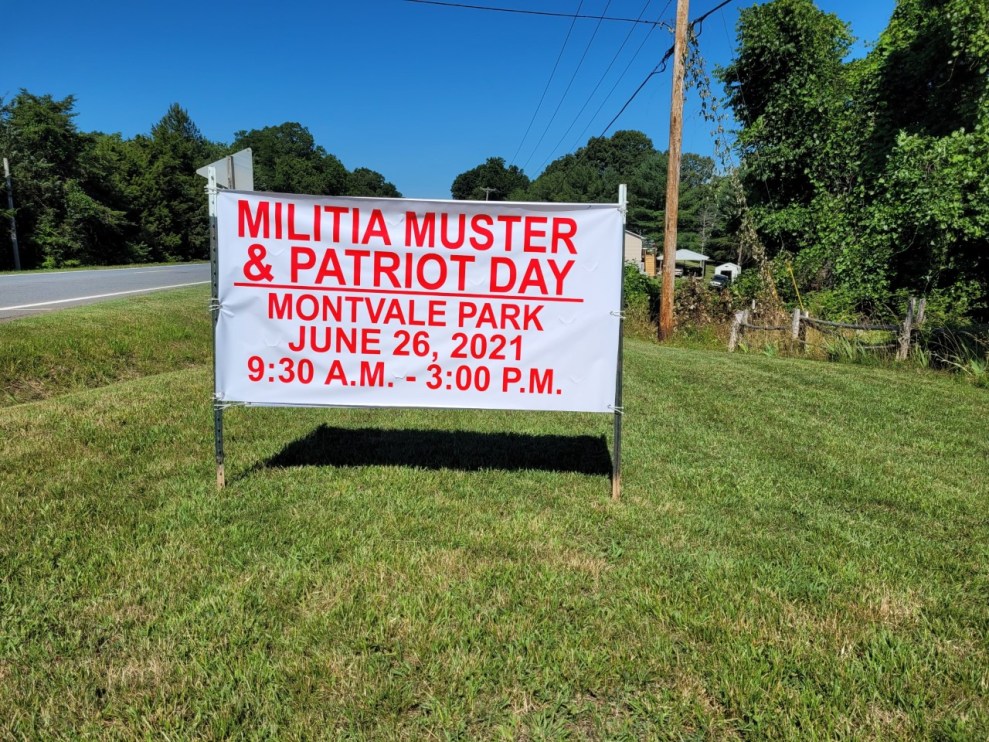
A roadside banner off a busy road in Bedford County promotes the militia’s second annual muster.
Donna StClair
The muster call said they were looking for “all able-bodied residents of the Commonwealth…who are at least 16 years of age and…not more than 55 years of age.” The purpose, the flyer said, was “to preserve tranquility, peace, and civil order by beginning to organize volunteers in the event that the full organization of the militia is required to defend the rights and liberties of the citizens of Bedford County.” They promised “an inspection of arms” with attendees encouraged to bring “a variant of the AR-15 platform.” Or any sort of rifle would do. The bright orange poster ended with a simple call. “Sic Semper Tyrannis!” More than 500 people showed up, eager to join the ranks.
Though Gardner and Abbott previously claimed to reporters that they were the leaders of the Bedford Militia, Falls, the militia’s current commanding officer, says that’s not true and instead claims the group’s first commanding officer, Kurt Feigel, was booted from that position after he told a reporter that the Second Amendment “is not about hunting. It’s not about self-defense. It’s about shooting tyrants in the face.” That sort of sentiment didn’t jibe with the friendly public image that the Bedford Militia’s leadership was hoping to cultivate in the wake of all the bad press over the Fifth and Federal protest.
Many gun rights advocates, including Van Cleave, saw the budding militia movement as the next logical step after the rise of Second Amendment Sanctuary movement that took over the state a few months earlier, with counties across Virginia vowing not to enforce any gun control laws passed by the state legislature. When the two county militias were formed in unison, the organizing committee for both of them convinced the boards of supervisors in Bedford and Campbell counties to pass a resolution that would essentially give the local government control over the militias. It was a calculated move to shed the extremist reputation that local militias had gained throughout the 1990s and 2000s and instead rebrand them as community-oriented groups of do-gooders. To burnish their image, both militias have periodically popped up to volunteer, such as when the Campbell Militia helped a local food pantry move hundreds of pounds of canned food to a local church for storage last year.
That made it easy for the Bedford County Board of Supervisors to adopt the resolution to formally recognize the militia. At the vote, County chair John Sharp rationalized that a formal recognition would give the group a stronger legal standing in court should it ever find itself legally challenging an “unconstitutional” gun law. Though he emphasized that the local government otherwise shouldn’t give the militia any sort of funding or endorsement, “I think the arm’s-length approach is the better approach to avoid liability,” he said at the hearing.
Bob Davis, another Bedford County supervisor who voted to recognize the militia, spoke in apocalyptic, biblical terms when I talked with him at the June muster. He told me that he sees this modern militia movement as a step toward the nation’s realignment, away from a more pluralistic society to what he views as its original ideals as a Christian nation. “I think our nation is in a bad state right now because citizens fail to understand our founding principles,” he said. “Our laws came from God, from the book of Leviticus and Deuteronomy. And along the way we got away from those principles that made us great.” Davis knows what the militias are really about, canned-food drives or no.

If you ask members of the Bedford Militia why they think it’s important for the group to exist, they’ll riff on the historical and constitutional context of militias. The Second Amendment, they’ll say, guarantees freedom for “a well regulated Militia” with a right to bear arms. And they’ll argue that the modern militia movement, which kicked off in the early 1990s, was never about anti-government extremism but rather a matter of true patriots slipping the yoke of the federal government and taking up the long twilight struggle for their constitutional freedoms—just as the Minutemen in the Revolutionary War did.
But the reality is that the modern militia movement—which counted some 5 million members and sympathizers at its peak in the mid-1990s—has always been an exercise in reimagining history. As Shane Bauer wrote for Mother Jones when he went undercover to report on a militia patrolling the southern border in 2016, “While today’s militia movement is made up of grassroots groups with the self-proclaimed mission of protecting the country against a tyrannical federal government, the militias enshrined in the Constitution were heavily regulated, top-down organizations.”
The modern militia boom has its origins in the aftermath of the Vietnam War. Kathleen Belew, a historian at the University of Chicago, locates the rise of paramilitarism within the story of white supremacy in the postwar period. “The story activists told about Vietnam and the response to the war on the right were major forces in uniting disparate strands of American white supremacism and in sustaining that unity,” she writes in Bring the War Home: The White Power Movement and Paramilitary America. “As narrated by white power proponents, the Vietnam War was a story of constant danger, gore, and horror. It was also a story of soldiers’ betrayal by military and political leaders and of the trivialization of their sacrifice. This narrative facilitated intergroup alliances and increased paramilitarism within the movement, escalating violence.”
Yet while the militias of the 1980s and ’90s sprang from a sense of post-Vietnam malaise, they also drew inspiration from the widespread belief that the US had been bested by the guerrilla insurgency tactics of the Vietcong. This was a bitter sort of American triumphalism. A scruffy band of nimble-footed irregulars in the jungles of Southeast Asia had taken on an imperial superpower and won—just like the Minutemen of the Revolutionary War. Myths were nesting within myths, as Garry Wills points out in his 1999 book, A Necessary Evil: A History of American Distrust of Government. “The conclusions drawn from a panel of military and academic experts have been amply confirmed in later studies: The North Vietnamese finally won by purely conventional means,” he writes.
The same was true of the Revolutionary War, in which the British army was not defeated by the insurgent tactics of a ragtag group of local farmers picking up guns but rather by the trained forces of the Continental Army. The militias of that era served a different purpose. “They were crucial to what was called, in the eighteenth century, the internal police,” Wills writes. “At a time of great turmoil, the stay-at-home militias kept order. The British tried to foment slave rebellions. The militias kept a close watch on the slave population. The British also used Indian allies to raid American communities. The militias, which did have a tradition of active rangers on guard against Indians, repelled them.”
As state militias professionalized and their ranks dwindled during the 19th century—eventually turning into the National Guard in the early 20th century—unofficial groups sprang up in their wake. Here we find the direct ancestors of modern militias. From the semi-underground Ku Klux Klan emerged a set of socially and politically blessed counterparts that operated to similar ends. “Radical Reconstruction leaders in several Southern states organized Negro militias (actually often racially mixed) both to defend the interests of the freedmen and to patrol and control elections,” Richard Hofstadter wrote in the 1970 book American Violence. “Southern whites reacted to this challenge to their supremacy by forming, under various names, White Leagues, politico-military organizations which, unlike the Ku Klux Klan, operated quite openly, conducting military drills and laying public plans for resistance. The White Leagues were, in effect, the armed wing of the Democratic Party. Their members seem to have welcomed, and on some occasions probably planned, riots as occasions upon which they could strike back against the Negro militias.”
Around the same time, the westward frontier of the country saw an explosion of extra-legal groups with a violent streak. “Vigilante groups may be defined as organizations formed to create and enforce laws of their own making in the supposed absence of adequate law enforcement,” Hofstadter writes. From there, the unofficial militias of the country turned to protecting the prerogatives of capital, with armed forces attacking strikers and union drives during the gilded age.
This is not the romantic history the reconstituted militias would like to evoke. Modern militias like the ones in Bedford and Campbell counties need to believe in what Wills calls “an almost magic power of ‘people’s war’ to prevail against the odds.” Not just because it gives them an ill-fated blueprint for a fight against federal tyranny when the time comes—and if you ask any militia member, that time will come—but because it also provides them with moral sanction for their crusade. Anti-government sedition is reimagined as the fullest expression of constitutional duty.

What Donna StClair remembers most about that first muster in 2020 was the terror and confusion at the nursing home adjacent to Falling Creek Park. “They were so scared,” she recalls. “They had no idea who these people were and why they had guns. They didn’t know if they should call the police or shelter in place.”
StClair, 70, has lived in Bedford County all her life and prides herself on her patriotism. “I believe, as a patriot, it’s my obligation that when I see my country doing something wrong—like keeping kids in cages—to pipe up,” she says. And so when she heard that people in her town were forming a militia, she decided she needed to do something.
On Facebook and other social media sites, StClair has become something of a pariah for her outspokenness against the militia and other far-right extremists in her community. Ever since she learned that a militia had formed in Bedford, she’s been posting on various popular local Facebook groups about the dangers of similar extremist militias, such as the Oath Keepers and Three Percenters adherents—two national militias that have a history of instigating violence.
It didn’t take long for StClair, an Army veteran and longtime Democratic activist, to draw the attention and ire of Gardner from the Campbell Militia. StClair and a friend, who wishes to remain anonymous out of fear of retaliation from the militia, took pictures of the Bedford Militia’s first muster and began to sound the alarm on Facebook and Twitter. A few weeks later, Gardner doxxed her on his Facebook page, posting pictures of her under the caption, “I’d like to thank our local crazy leftist Mrs StClaire [sic] for coming out to support our rally on Saturday. Next time you should stay and say hello.” In the comments, people identified StClair’s car and other identifying information about her. Months later, StClair, along with others who had spoken out against the Bedford Militia on social media, received mysterious letters in their mailbox—handwritten envelopes with no return address or stamp, filled with Trump 2020 propaganda. StClair is convinced it was a warning from the Bedford Militia, since the only other people she knows who received the letter were vocal militia opponents. “It was a message saying, ‘Hey, we know where you live.’”
Last October, StClair and her same friend attended another Bedford Militia rally. After a few hours of watching the speeches from afar, StClair and her friend began to head home. As they walked back to their car, a man chased them down to ask what they thought of the rally. “It was fine—why?” StClair asked. “Well, what did you think of all this gun stuff and everything?” the man replied. “Well, I guess that’s what makes America America,” StClair’s friend said as they inched to their car. StClair says the man then sprinted in front of them, twirling around with a knowing smile, and said, “Gee, it’s nice to meet you, Donna.”
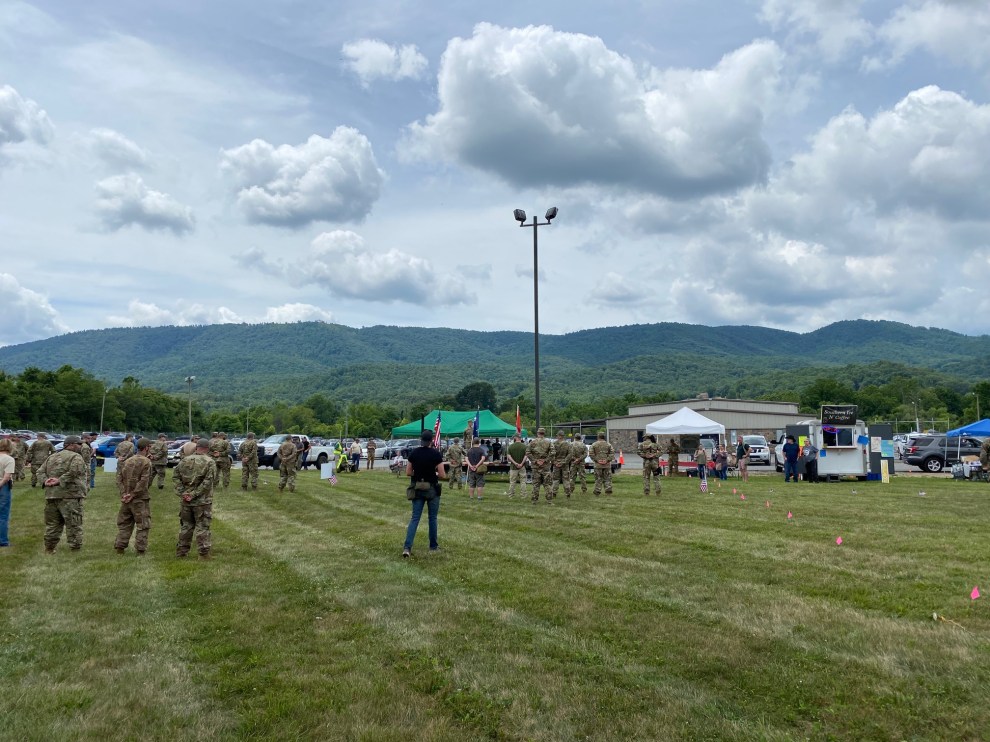
In April, StClair found herself the target of a lawsuit. George Caylor, a financial adviser and host of a popular local tea party–branded talk radio show, sued StClair and two other individuals for allegedly posting defamatory comments on Facebook. Caylor boarded one of two buses that left from the Lynchburg area with more than 100 people to Washington, DC, on January 6 for the “Stop the Steal” rally on the Ellipse. On Facebook, StClair and the two other defendants called Caylor an “insurrectionist” and, in a private Facebook group, identified 41 people who were on the buses from Caylor’s public photos, calling for them to be arrested. Caylor maintains that neither he nor anyone that traveled with his group took part in the insurrection attempt at the US Capitol. The lawsuit claims that StClair also sent a message to MassMutual, where Caylor worked, that led to the company asking for his resignation. He is now demanding $1.7 million in damages from StClair and the two other defendants.
While Caylor’s public connection to the Bedford Militia is tenuous at best, news of the lawsuit reignited the harassment campaign against StClair from the militia. In a thread about the lawsuit on the gun discussion forum AR15.com, multiple anonymous users posted threats targeting StClair, with language she says is “eerily similar” to the threats she received from militia members. “Would be a shame if her address and place of work (if she even works) were posted publicly somewhere,” one user wrote. Another replied, “It is if you google her name.” Others posted vague references to knowing where StClair lives, along with intimations of violence: “Donna’s lawn looks like shit,” wrote one user. “For shame [if] anything happened to her…I wouldn’t lose any sleep over it,” another user wrote.
The harassment doesn’t stop with StClair. I spoke with multiple Bedford County and Lynchburg residents who told me about the harassment they’ve received over their public comments disapproving of the militia. All of them spoke on the condition of anonymity because they worried about retaliation from militia members and their supporters. One person told me that, after speaking publicly at a Board of Supervisors meeting against the militia resolution, they received a flood of disparaging comments on their Facebook page and, similar to StClair, weeks later found Trump 2020 flyers in an unmarked, unstamped envelope in their mailbox. Other members of the Bedford Democratic committee said they received similar letters after publicly speaking out against the militia. In the days after the incident at Fifth and Federal, one woman, who is Black, posted on a Lynchburg community Facebook page about the threat of the militia and how their presence led to the violence that erupted that night. In response, a man who claimed to be a member of the Campbell Militia fired back at the woman, threatening to “lay you down next to your best friend George Floyd.” He then threatened to kill her son. “Bring the boy too,” he wrote, “we’ll lay him with you.”

If it weren’t for the military fatigues and guns, a passerby might easily mistake the Bedford Militia for just another community service group. Its muster this summer was friendly and jovial—kids ran around as their parents lounged in the sun and munched on tacos and barbecue. And everyone I talked to went to great lengths to praise the militia for its help in the community; one man said that he called on the militia to help move thousands of hay bales on his farm. But it wasn’t hard to find the signs of the extremism lurking just below the surface. Some people in attendance weren’t just packing heat. They were carrying AR-15–style assault weapons. The flyer for the muster—much like the original gathering in 2020—encouraged attendees to specifically bring unloaded semi-automatic weapons. And wedged between a jewelry tent and the barbecue station was a tent where the VCDL had a table filled with guns and literature about its organization and how people can get involved to help fight the Democrats’ tyranny.
Ever since the Democratic majority took hold in Virginia, the VCDL has been instrumental in organizing coalitions not just to block gun control legislation but to support pro–Second Amendment measures like Bedford’s militia resolution in counties and municipalities across the state. When a county like Bedford mulls recognizing the local militia, the VCDL, through its vast network of supporters, will flood county hearings, essentially crowding anyone who wants to voice their opposition, which is exactly what happened to one person in Lynchburg whom I spoke with on the condition of anonymity. “So not only does this have a serious public safety impact,” says McCord, the executive director of Georgetown Law’s Institute for Constitutional Advocacy and Protection, “but it thwarts First Amendment rights of those with disagreeing views.”
In the aftermath of the insurrection attempt on January 6, the threat posed by these groups trying to legitimize themselves could not be graver, McCord says. Paramilitary groups like the Bedford and Campbell militias often like to hold training camps—in violation of state law—to prepare their members for what to do in the event they’re called into a situation involving some sort of civil disorder. But the problem, according to McCord, is that these groups themselves are deciding where and when they should show up, whether it be at the Capitol on January 6 or “when Black Lives Matter high school students march down the street in protest.”
Falls, the Bedford Militia commander, says he hopes to shift that image. “We’re trying to get away from this preconceived notion of what a militia is—a bunch of rednecks running around unorganized, undisciplined,” he tells me, as if an organized and disciplined band of paramilitaries were a more reassuring sight. In any case it wasn’t exactly an easy idea to take with a straight face as he spoke to me while militia members carrying AR-15–style weapons walked by. “Our message that we’re trying to get across is that we’re very much for the defense, we’re very much for the Second Amendment, but at the core we’re here to support the community,” he adds.
Whatever the militias’ stated intent, experts like McCord and Mark Pitcavage, a senior research fellow at the Anti-Defamation League’s Center on Extremism, are on high alert. Localities in Virginia and beyond are treating anti-government groups as if they were nothing more extreme than a local Kiwanis club. Pitcavage points to Landor and Lyon counties in Nevada, which recently became members of the Constitutional Sheriffs and Peace Officers Association, a far-right group of local police officers that promotes the idea of local sheriffs as the sole authority to fight federal tyranny. The group is led by Richard Mack, a former Arizona sheriff and founding board member of the Oath Keepers. “And so there you actually have counties joining an extremist group, which is even worse than what’s happening in Virginia,” he says.
These are signs of civic capitulation. “The key problem here is that you have what are, by all accounts, extremist groups, getting an official recognition and imprimatur of an actual level of government,” Pitcavage says. “It fools people into thinking these are innocuous groups. That these groups somehow have legitimacy. When in fact they don’t—they’re not innocuous, they don’t have legitimacy. And, in fact, they have a very dangerous set of ideas.”
